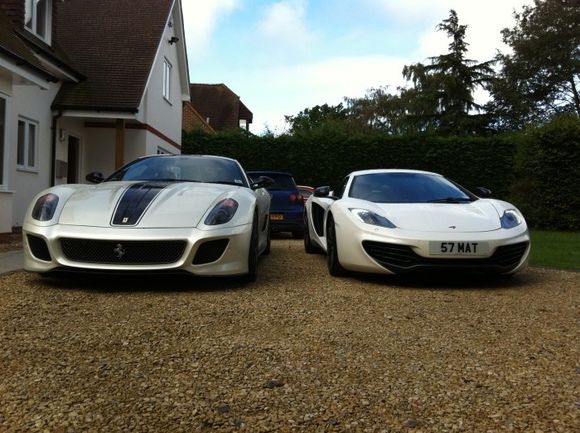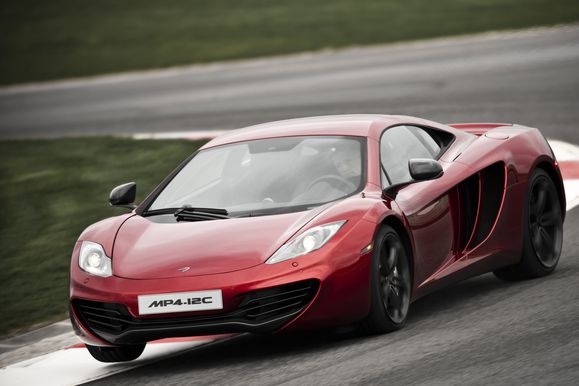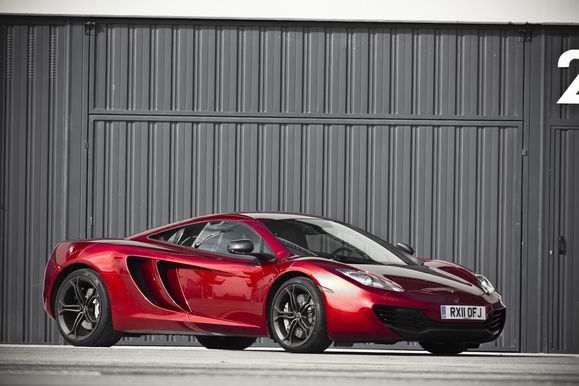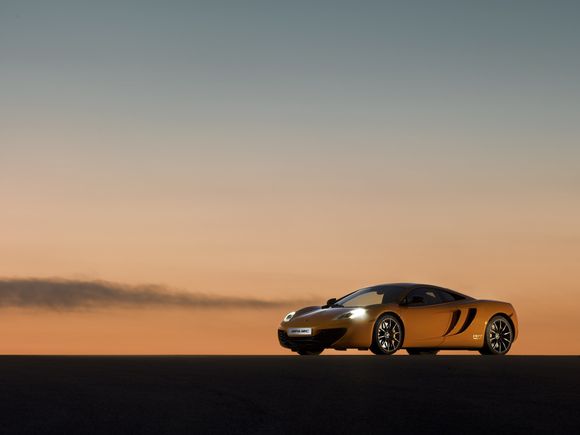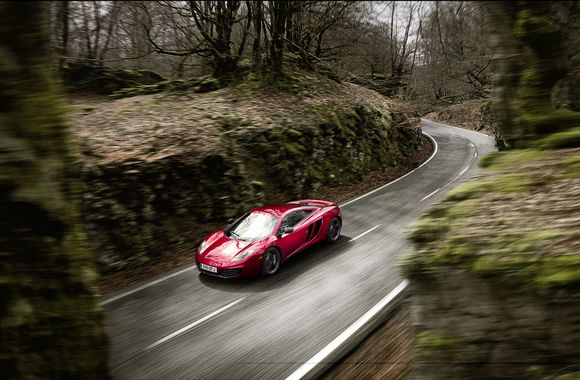First cars are being delivered, at least in UK. Maff has kindly allowed me to publish here the very complete report he has posted on Piston Heads, a report which I assume will be completed over the next weeks or months. So stay tuned ! Pictures from the original article.
Sept. 20th
After a wait for a few issues to be sorted by the dealer I picked her up this afternoon, and, WOW!
The McLaren has a lot more visual appearance on the road than any photo's portray, and has quite a stance. The interior fit and finish is very good, better than the Ferrari's, exterior fit and finish is probably on par.
I happened to be driving my GTO and California this morning, and got straight out of those and into the MP4-12C. The first thing I noticed is how small the McLaren feels compared to the Ferrari's, but its actual size is slightly bigger than a California.
The MP4 feels much more nimble than the GTO, but most of that will be down to the weight difference. The MP4 is certainly quicker than the GTO once it gets going, and it pulls like nothing I have driven before once you get to 4500rpm all the way to 8500rpm. However I would guess from a standing start the GTO would pull away, as the GTO just sits down and goes off the line with no wheelspin at all, whereas the McLaren gets a lot of wheelspin and needs to be modulated, I assume due to the turbo torque kicking in. Once the McLaren is up to 80mph or so then it would start to pull away at quite some speed from the GTO. The McLaren really IS quick once rolling and I would be amazed if at motorway speeds anything bar a Veyron would currently pass it (except modified cars 
Oh, and one thing I was not expecting! The noise!!!! I have the optional sports lightweight exhaust and inside the cabin the exhaust/engine noise is much louder than the GTO, not sure how that compares outside - I would guess the GTO is louder.
I drove the GTO and MP4 back to back on my local twisty hilly roads and the MP4 does handle better than I expected. In comparison the GTO just simply sticks and does not slide very much at all unless properly provoked or driven in a very agressive manner, whereas I found the MP4 to be a little more playful than the GTO but still very well balanced, and the GTO would have its work cut out trying to keep up with the MP4 on the twisties.
Ride is very good, nicely sprung and still dampened to what you would expect. Sometimes feels a but floaty but only in a straight line over undulations, paint finish is very good, better than Aston, Ferrari.
And the not so good bits:
- Seats don't have enough adjustment for height and backrest (and these are the optional electric memory ones)
- interior does feel a bit small, but then as a plus it makes the car feel smaller than it is
- TURBO LAG! Below 3000rpm the small engine does show through. You really have to be above 3000rpm all the time otherwise it feels like I am driving my smart car. There really is virtually no get up and go at all compared to my similar cars. Even compared to my California and C63 AMG below 2000rpm its lousy and between 2000 and 3000rpm its just about on par. To be fair my other cars are NA, but you know its a turbo engined car in the McLaren. And once the power does come on when you back off to brake at say 6000rpm it feels as if the power is still being delivered for a very short amount of time, as if the turbo is still 'un-spooling' which I found a little strange.
- Throttle response leaves a little to be desired. Maybe harsh comparing it with the GTO which is just perfect, but I did expect a little better.
- I wont mention the 'launch car' issues as these have been mentioned in other posts, but they did detract from the experience.
Overall, even with the items above it is a still a great car, and something for McLaren to be proud of. Yes its not perfect, but some of the issues above could be sorted out over time. My main gripes are with the turbo lag and responsiveness, and should be issues that can be fixed.
Some may say its not fair to compare to a 599 GTO which costs over £110k more than the MP4-12C, but its just my way of comparing to what I know very well (>7000 miles on my GTO now and numerous track days).
The MP4 will be put through the same paces as my other cars so it will be interesting to see how it develops with some use and track days.
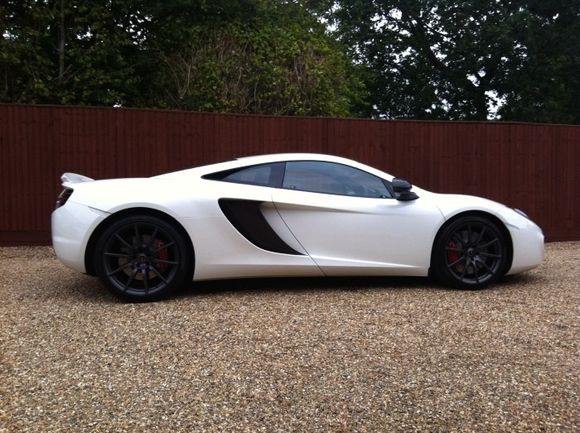 Blog admin opinion on the car: Very interesting specification, with a nice combination of black touches, in particular on the turning vanes, with the white body color.
Blog admin opinion on the car: Very interesting specification, with a nice combination of black touches, in particular on the turning vanes, with the white body color.
Sept. 21st
One day on and 100 mile more, and two faults so far, first was an exhaust valve fault, which put the car into limp mode. Pulled over, switched it off, locked it and after 2 minutes it thankfully sorted itself back out again. Phew.
Then 20 miles later an 'ESC Fault' appeared on the dash, and none of the handling or powertrain buttons worked and dash reset to default mode. Switched off in traffic, restarted and fault cleared. Again. Phew.
Oh, and whilst listing to the iPod, the media center rebooted itself for no reason. TO be fair IRIS is not in a very healthy state on all cars, but at least the iPod part works. Or did.
Hope it gets better from here on!!!
- 599 GTO or McLaren if I had to keep one? GTO. Its just a better car, maybe only 90% as fast but just an all round great car. I could see myself getting board of the McLaren, not of the GTO.
- Steels or carbon brakes? I have the steels and they feel fine feedback wise, and do slow it down very well, however I do now wish that I would have spec'ed the carbon ones, as I can see the standard pads/disks wearing out pretty quickly due to the shear speed of the thing and all the braking thats needed!
- Comparison of size to the GTO. See pics below, but I was surprised this morning when I put them side by side to find them exactly the same length and width, and the GTO is large!!
Well what can I say?!
A week on with the car and I have been using it every day. In 'normal/normal' mode (drivtrain/handling) and the aero off, and auto mode its easier to drive and more comfortable than my C63.
However, in track/track mode, or even track/sport the car is a different car. The exhaust flaps open and it is proper loud, the suspension changes and it feels as if I have just got in a different car.
In summary, F**k me what a car.
I like to think I drive my cars pretty hard, to give you an idea my 8 month old 599 GTO is already 20% through its near lifetime CCM3 carbon ceramics, and my California of the same age is ready for a re-spray due to stone chips.
I've been giving the MP4 a pretty hard time now she is run in, and I really can not believe what I am experiencing. The initial issues I had with the throttle response, whilst still not perfect has become much less of an issue, and in track mode is much better. The turbo lag is also less of an issue once you learn the 7 speed box's ratio's.
My absolute certain conclusion: This is the fastest car I have ever driven. There is NO way my GTO would hang with the MP4 on a British A or B road. Zero. I can 100% agree with the top gear lap times. I have driven a ot of cars, tracked and raced numerous, and I do not know of another road car that could keep up with the MP4 being driven in anger.
Even the new Aventador, unless it can shed 200kg don't even bother trying, its that quick.
The precision of the turn in sublime, the handling is the best I have ever experienced, the balance is perfect, and for a car that does NOT have a LSD, it beggars belief. I do not know how a car that limits its wheel spin via electronically breaking the spinning wheel does it. I am sure most of us have driven a car without a diff and felt what happens when the traction control brakes the spiining wheel and its not good (C63 for example!), but in the McLaren it just goes, and when it does slip it drifts beautifully with good control.
Yes the GTO is a nicer car to drive, the GTO feels more mechanical, and that V12, but if you want to go for a complete balls out blast at speeds that seem impossible, the McLaren is the car to do it in.
And its not been without problems, 12 electrical faults with the car and counting, I've lost part of the front wing guard, and it stranded me in London at midnight on Friday refusing to start after 30 minutes of trying, but hopefully these issues will be fixed this week.
How some of the magazines found this car slower round a track is beyond me, maybe the most recent updates to the McLaren last week sorted these issues, but thats my next test... track day booked. 

